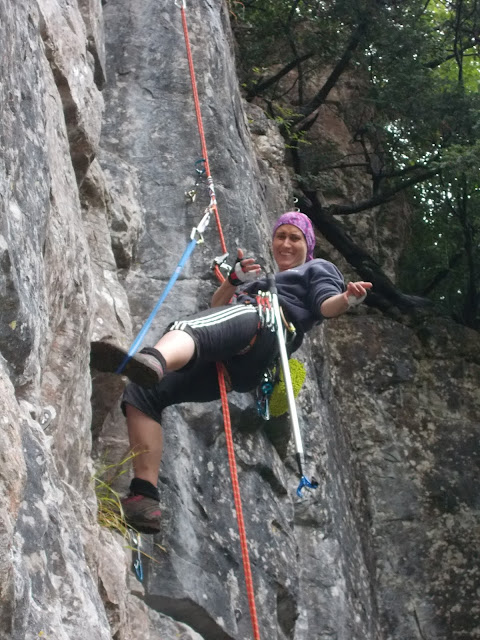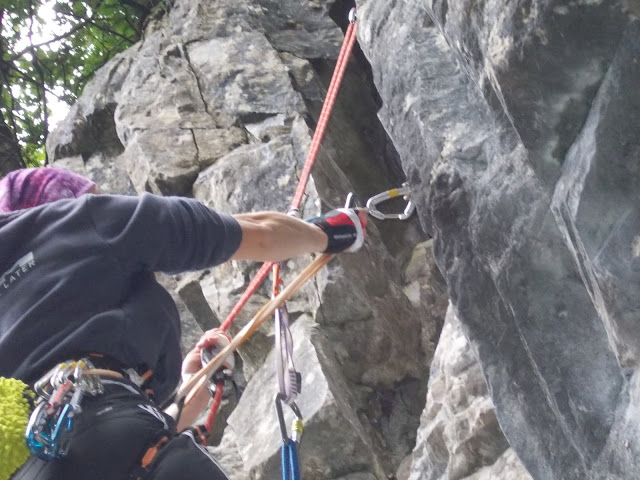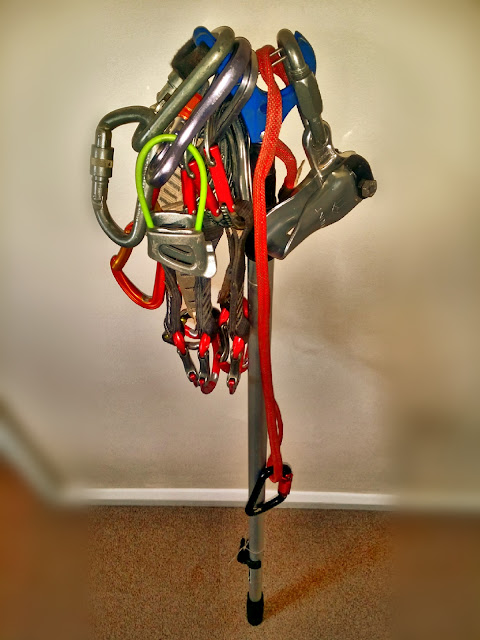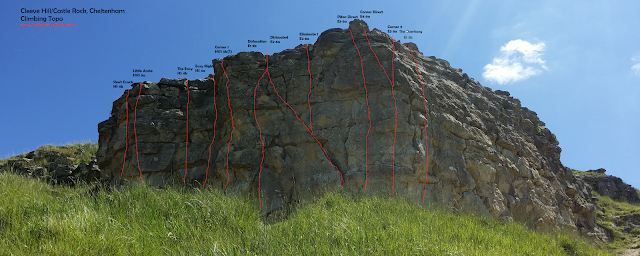How to Top Rope Solo with a Shunt
We've all been there...Spring has arrived and a beautiful day has been forecast. Full sun, light winds, perfect for a days climb. Trouble is, no-one is free to join you. How can you climb on your own?
You may have seen a bearded veteran once at the crag, solo but with a rope and a hammer hanging off the end. "What is all that about?", you ask. "It doesn't look safe".
As we all know, climbing is as safe as we make it. Using proven systems to negate the risks which help us to enjoy this sport where for a lot of the time, we are at height. Soloing with a shunt as a backup is dangerous and just like when leading, we need to negate the risks so that our chance of injury is extremely low.
You can find a handful of guides online for top rope soloing, in this guide I will explain my method with pictures for clarity. This is a guide only for the competent and I advise you to practice these methods with extreme caution. Don't let this put you off learning however, solo ascents are quite common in climbing, roped and unroped. It doesn't take a rocket scientist to work out which is more risky.
The number one rule I use for top rope soloing: ALWAYS HAVE AT LEAST TWO POINTS OF REDUNDANCY BETWEEN YOU AND THE GROUND.
Setting up the "top rope" aka the anchors
Setting up the anchor can be as easy or as hard as you dare and by using the "frigging method", even multipitch sport is possible.
Let's start with the easy way. For crags with good anchors and access to the top, simply setup your anchor as you would a belay and then abseil down your chosen route to climb.
Personally I would want a very sturdy tree, 2 ground stakes or an anchor which involved 2-3 bomber placements. At a guess, top rope soloing shouldn't produce any more force than 5KN/500kg.
The "Frigging Method"
As it is not straight forward, I will talk in great detail about this.
The "frigging method" uses a clip stick. This obviously requires you to be climbing a well bolted sport route (with good anchors). It also requires a little time to setup and trust me, you will be warm after doing so.
I start by extending the clipstick as far as possible to ascertain the highest bolt on the route I can reach and clip. Using the clipstick I will clip the highest bolt, plus one below it into the rope (via quick draws). The two bolts are your two points of redundancy here.
This is where you can use a variety of methods to ascend both strands of the rope to the anchors. When you ascend the rope the first time, the rope will not be weighted below you and the shunt will not move up the rope freely. Therefore it is down to you to pull the slack through the bottom of the shunt as you go.
Method one - Climb the route
If the route is within your grade, it may be easier to climb the route up to the first clipped bolt while you are connected to the shunt. I will usually pull through any cruxs using the other methods as not to exhaust myself prior to working or climbing it.
Method two - Thug your way up
Similar to when you "bump" your way up through a crux when red pointing with a belayer, "thugging" involves one hand on the brake end (under the shunt) and one hand above the shunt to pull up on the rope. As you pull up, quickly and fluidly take in the slack from under the shunt. It makes it a lot easier using your legs tactically with drop knees ect to aid the movement. This method does have a "knack".
Method three - Prussic up the rope
When showing my top rope soloing method to one of my climbing partners, Eava found it difficult using the "thug" method. Instead she used a prussic above the shunt, with a foot loop to step into. Essentially she was using her foot loop to stand on while she took the slack in from under the shunt.
I will add at this point that the two bolts act as our two points of redundancy. The shunt however is not backed up. Although (similar to an abseil setup) the "break hand" is active while ascending the rope, so personally I deem this as a backup. The shunt is never going to slip while weighted from your belay loop. Back up the rope with knots if you have any concerns about my method.
Using your clipstick (yes you need to take that up with you) and taking slack through the shunt, clip the next highest unclipped bolt. For a short 10m route, you may even be able to reach the chains/top anchor. In this instance if there are two anchor bolts, clip those.
Use only enough slack as you need to clip the high bolt. If the bolt failed which you are are attached to now (via your sling), you'd weight the highest bolt the rope is clipped to and any slack would lengthen a fall. (Worth adding here why it may be a good idea to use dynamic climbing rope and not static for top rope soloing?)
Repeat this method, bolt to bolt, until the anchors can be clipped. Once I have clipped the anchors (with two quickdraws), I will then ascend straight to those, unclipping any other quickdraws from the rope on the way.
Some of you may wish to setup a static anchor instead of a "running" top rope anchor. Personally I like the fact that I can pull the rope anytime.
Now weight your abseil device and once you are happy, unclip your sling from the anchors to then abseil down the rope. Just remember to bring the shunt down the rope with you (as it cannot be unclipped from the rope). For longer routes I have a method of automatically descending with the shunt running freely (see pic).
The shunt is attached to your belay loop as previously explained. Use a robust locking carabiner, preferably a mallion as these have a high (side on) breaking strength compared to a normal crab. The shunt automatically clamps the rope in a fall situation, with your weight effectively keeping it shut.
Weight the rope
To make life easier on yourself while climbing the route, weight the rope (both strands) at the bottom of the route. This allows the shunt to move freely with you, as you climb. You do not need to stop and pull it up as you did while ascending.
For this I usually use my rucksack, clipped to a (quick to tie) knot like an alpine butterfly via a carabiner.
Descending/bailing a route
To descend a route at any time on a sports route, make yourself safe and attach your harness sling to the nearest bolt and proceed to setup your abseil device on both strands of the rope. Remove yourself from the shunt and abseil down.
To descend from a route with no bolts while mid-route it can be a little trickier to do while keeping two points of redundancy. Setup your abseil device on both strands of the rope below the shunt. Now tie an overhand knot a little way below that (as a backup, you could always use a prussic instead). Clip your harness sling to the mallion of the shunt and then remove yourself from the mallion (and therefore the shunt) WHILE HOLDING THE BRAKE HAND OF THE ROPE! which is exiting your abseil device. Untie the backup knot below (with one hand), unclip sling from the shunt (or orientate it as shown above for it to follow you down), the continue to abseil down both strands of the rope.
Long winded but makes sense once you have done it a few times.
For an easy/scary way to descend, use at your peril. Unweight the shunt by grabbing the rope above and push in the cam, you are now free to move some slack though. Then let go and fall onto the slack. A fun experience and can be a quick way once you have the knack!
The shunt experience
It is surprisingly easy to climb in this way and working routes on a shunt can be an excellent way to practice moves in peace. The shunt does not slip either, allowing you to stay right on the crux if necessary. Also, the shunt never gets bored of belaying!
Add a knot
To add a point of redundancy while climbing, tie a knot under the shunt as many times as you need throughout the route, to protect yourself against the shunt failing to grab the rope. The mechanics of the shunt make this scenario very rare, however it can happen when the carabiner gets caught in such a way that the shunt is forced open. A knot in this situation would stop you riding the shunt to the ground.
Can you use one strand of rope?
Yes, on rope between 10-11mm (safety information from Petzl here). This can allow you to abseil in and climb a route The full length of the rope if you wish. To make life easier and to stop a large swing on a wondering route you simply clip the rope into quick draws on your descent, to then unclip them as you pass them climbing.
Rope protectors are a good idea
One last point I will make. Use rope protectors where the rope runs over rough edges near the anchor. They cost nothing and not only extend rope life but extend yours too!
Happy shunting! :)
I am aware of the controversy surrounding roped soloing and methods used. Talking to people about this method has helped me improve its safety (and remove the faff) for my method. So please feel free to discuss any points, positive or negative.
There is a great group for discussing top rope soloing on Facebook Rope Solo Climbing. I would recommend a look if you use Facebook.
Oh and please share this if you found this article useful ;)
The "frigging method" uses a clip stick. This obviously requires you to be climbing a well bolted sport route (with good anchors). It also requires a little time to setup and trust me, you will be warm after doing so.
I start by extending the clipstick as far as possible to ascertain the highest bolt on the route I can reach and clip. Using the clipstick I will clip the highest bolt, plus one below it into the rope (via quick draws). The two bolts are your two points of redundancy here.
This is where you can use a variety of methods to ascend both strands of the rope to the anchors. When you ascend the rope the first time, the rope will not be weighted below you and the shunt will not move up the rope freely. Therefore it is down to you to pull the slack through the bottom of the shunt as you go.
Method one - Climb the route
If the route is within your grade, it may be easier to climb the route up to the first clipped bolt while you are connected to the shunt. I will usually pull through any cruxs using the other methods as not to exhaust myself prior to working or climbing it.
Method two - Thug your way up
Similar to when you "bump" your way up through a crux when red pointing with a belayer, "thugging" involves one hand on the brake end (under the shunt) and one hand above the shunt to pull up on the rope. As you pull up, quickly and fluidly take in the slack from under the shunt. It makes it a lot easier using your legs tactically with drop knees ect to aid the movement. This method does have a "knack".
Method three - Prussic up the rope
When showing my top rope soloing method to one of my climbing partners, Eava found it difficult using the "thug" method. Instead she used a prussic above the shunt, with a foot loop to step into. Essentially she was using her foot loop to stand on while she took the slack in from under the shunt.
 |
| Shunt attached to harness belay loop via a mallion. Two bolts clipped. Using a prussic attached to a foot loop to stand on while taking in slack from under the shunt, ascending the rope. |
I will add at this point that the two bolts act as our two points of redundancy. The shunt however is not backed up. Although (similar to an abseil setup) the "break hand" is active while ascending the rope, so personally I deem this as a backup. The shunt is never going to slip while weighted from your belay loop. Back up the rope with knots if you have any concerns about my method.
Get to the first bolt, then what?
Using a sling and carabiner (attached to your belay loop), clip into the first bolt. I use a quick locking carabiner for this. This is a point of redundancy. Weight the sling and loosen the rope through the shunt.Using your clipstick (yes you need to take that up with you) and taking slack through the shunt, clip the next highest unclipped bolt. For a short 10m route, you may even be able to reach the chains/top anchor. In this instance if there are two anchor bolts, clip those.
Use only enough slack as you need to clip the high bolt. If the bolt failed which you are are attached to now (via your sling), you'd weight the highest bolt the rope is clipped to and any slack would lengthen a fall. (Worth adding here why it may be a good idea to use dynamic climbing rope and not static for top rope soloing?)
 |
| When you reach the first bolt, clip into it with your sling |
Repeat this method, bolt to bolt, until the anchors can be clipped. Once I have clipped the anchors (with two quickdraws), I will then ascend straight to those, unclipping any other quickdraws from the rope on the way.
Once at the anchors
Straight away, clip your sling to one of the anchor bolts. Then, similar to setting up a top rope on a bolted route, I will use two locking carabiners and attach one to either anchor ring (or bolt). Clip the rope into them both, lock them and unclip the (pre clipped) quickdraws from the rope and anchors.Some of you may wish to setup a static anchor instead of a "running" top rope anchor. Personally I like the fact that I can pull the rope anytime.
Descend the route
Once you are happy with the top rope setup and while you are still clipped into a bolt via your sling, set yourself up to abseil down (both strands!) of the rope. Once this is done, keeping a loose hand on the brake end of your abseil device, unscrew the mallion from the shunt and effectively remove yourself from the shunt.Now weight your abseil device and once you are happy, unclip your sling from the anchors to then abseil down the rope. Just remember to bring the shunt down the rope with you (as it cannot be unclipped from the rope). For longer routes I have a method of automatically descending with the shunt running freely (see pic).
 |
| The orientation of the mallion keeps the shunt from locking while abseiling. The sling from you harness acts as a "lead", trailing it down with you. |
Top Rope soloing with a shunt. "Shunting" a route.
Use a mallion
Weight the rope
To make life easier on yourself while climbing the route, weight the rope (both strands) at the bottom of the route. This allows the shunt to move freely with you, as you climb. You do not need to stop and pull it up as you did while ascending.
For this I usually use my rucksack, clipped to a (quick to tie) knot like an alpine butterfly via a carabiner.
Descending/bailing a route
To descend a route at any time on a sports route, make yourself safe and attach your harness sling to the nearest bolt and proceed to setup your abseil device on both strands of the rope. Remove yourself from the shunt and abseil down.
To descend from a route with no bolts while mid-route it can be a little trickier to do while keeping two points of redundancy. Setup your abseil device on both strands of the rope below the shunt. Now tie an overhand knot a little way below that (as a backup, you could always use a prussic instead). Clip your harness sling to the mallion of the shunt and then remove yourself from the mallion (and therefore the shunt) WHILE HOLDING THE BRAKE HAND OF THE ROPE! which is exiting your abseil device. Untie the backup knot below (with one hand), unclip sling from the shunt (or orientate it as shown above for it to follow you down), the continue to abseil down both strands of the rope.
Long winded but makes sense once you have done it a few times.
For an easy/scary way to descend, use at your peril. Unweight the shunt by grabbing the rope above and push in the cam, you are now free to move some slack though. Then let go and fall onto the slack. A fun experience and can be a quick way once you have the knack!
The shunt experience
It is surprisingly easy to climb in this way and working routes on a shunt can be an excellent way to practice moves in peace. The shunt does not slip either, allowing you to stay right on the crux if necessary. Also, the shunt never gets bored of belaying!
Add a knot
To add a point of redundancy while climbing, tie a knot under the shunt as many times as you need throughout the route, to protect yourself against the shunt failing to grab the rope. The mechanics of the shunt make this scenario very rare, however it can happen when the carabiner gets caught in such a way that the shunt is forced open. A knot in this situation would stop you riding the shunt to the ground.
Can you use one strand of rope?
Yes, on rope between 10-11mm (safety information from Petzl here). This can allow you to abseil in and climb a route The full length of the rope if you wish. To make life easier and to stop a large swing on a wondering route you simply clip the rope into quick draws on your descent, to then unclip them as you pass them climbing.
Rope protectors are a good idea
One last point I will make. Use rope protectors where the rope runs over rough edges near the anchor. They cost nothing and not only extend rope life but extend yours too!
Happy shunting! :)
 |
| Me happy while shunting but bloody cold mind you, it was February |
I am aware of the controversy surrounding roped soloing and methods used. Talking to people about this method has helped me improve its safety (and remove the faff) for my method. So please feel free to discuss any points, positive or negative.
There is a great group for discussing top rope soloing on Facebook Rope Solo Climbing. I would recommend a look if you use Facebook.
Oh and please share this if you found this article useful ;)





